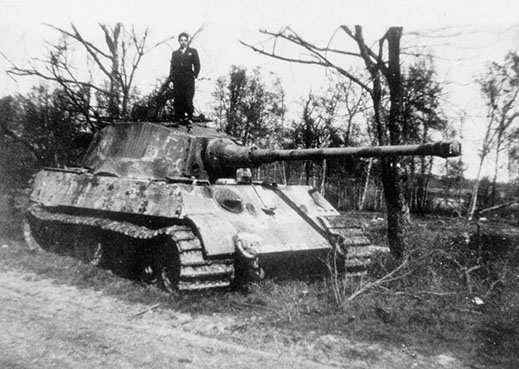
crédit Photo : © Droits réservés
Choose your language ![]() Wähle deine Sprache
Wähle deine Sprache


Choose your language ![]() Wähle deine Sprache
Wähle deine Sprache
Poursuivre sur le chemin jusqu’à la D 913, la traverser prudemment et descendre sur Sailly où se situe le panneau (8) « Bloody Sailly ».

In front of you, the village of Sailly which was pointed out on the 28 august 1944 as the target for the 315th Infantry Regiment with the support of the 749th Tank Battalion. The American artillery concentrated the fires of ten battalions. The fight lasted all day.
THE TIGERS CAME OUT OF THE WOODS
The village is actually only defended but by a combat group of some 400 men, under the commandment of the Oberst Ernst Mangold, a 38-year-old colonel. He received order from General von Tresckow to stay until the last fallen man. Four Tiger tanks were at his disposal, two from the squadron 503 and two from the 101e SS as well as two Sturmgeschütze from Pz. Jäg. 18. Leutnant Finkeldei’s anti-tanks were in position on the edge of the prairie.
Being sufficiently powerful to knock down in one go the big trees on their way, the Tigers came out from the woods. Walter Jung, the driver of Tiger n°301 - and who is a baker in civil life - will later recall : “near noon (…) we were harassed by the shots from the artillery and the American anti-tanks; the Tiger caught fire, we evacuated straight away but our radio operator, Klaus Ricke, was badly wounded, we had to take him to the aid station (Prieuré de Montcient), where he was taken care of, but it was unfortunately too late and Ricke died.”
When the American attack came out from the woods, the ‘B’ company, led by the daring Captain Alexander Patchsur met intense and targeted firing. The chief of section, Lieutenant John Murray, was mowed down while Captain Patch was himself shot in the knee. Seeing his officers and men being decimated, he revived the attack, refusing evacuation during more than two hours. Shot in the shoulder, slowly weakened by the haemorrhage, he willingly waited until the end of the battle to seek medical help.
On 23rd August there was already one victim from the combats, Lieutenant Roger Wood, shot down not far away, on board his Thunderbolt P-47. If you pay close attention you shall notice along the way, under cover, the traces of the ‘men holes’ that were filled up. There were about ten of these individual defence shelters which were hastily dug by the soldiers of both camps to protect themselves from the explosive devices and the shrapnels’ anarchic spreading.

Vor Ihnen liegt das Dorf Sailly, das am 28. August 1944 zum Ziel des 315th Infantry Regiment wurde, das von den Panzern des 749th Tank Battalion unterstützt wurde. Die amerikanische Artillerie sollte dort das Feuer von zehn Bataillonen konzentrieren. Die Schlacht dauerte einen ganzen Tag lang.
DIE TIGER KOMMEN AUS DEM WALD
In Wirklichkeit wurde das Dorf nur noch von einer Kampfgruppe von etwa vierhundert Mann unter dem Kommando des 38-jährigen Obersts Ernst Mangold verteidigt. Er hatte von General von Tresckow den Befehl erhalten, bis zum letzten Mann durchzuhalten. Ihm standen vier Tiger-Panzer zur Verfügung, zwei von der Einheit 503 und zwei vom 101 SS-Panzerbataillon, sowie zwei Sturmgeschütze von der Panzerjäger-Abteilung 18. Die Panzerabwehrkanonen von Leutnant Finkeldei waren am Rand der Ebene in Stellung.
Die Tiger waren stark genug, um die großen Bäume, die ihnen den Weg versperrten, umzureißen, und tauchten plötzlich aus dem Wald auf. Walter Jung, der Fahrer des Tigers Nr. 301 - er war im Zivilleben Bäcker - erinnerte sich später: „Um die Mittagszeit (...) wurden wir von amerikanischer Artillerie und Panzerabwehr stark beschossen; der Tiger fing Feuer, wir evakuierten sofort, aber unser Funker, Klaus Ricke, war schwer verwundet und wir brachten ihn zum ersten Rettungsposten (Prieuré de Montcient), wo er behandelt wurde, aber es war zu spät und Ricke ist gestorben.“
Als die Amerikaner aus dem Wald heraus angriffen, geriet die „B“-Kompanie unter der Führung des unerschrockenen Captain Alexander Patch unter schweres und präzises Feuer. Der Gruppenführer, Leutnant John Murray, wurde niedergeschossen, während Captain Patch selbst von einer Kugel am Knie getroffen wurde. Als er sah, dass seine Offiziere und Männer der Reihe nach fielen, griff er erneut an und weigerte sich über zwei Stunden lang, evakuieren zu lassen. Erneut von einer Kugel an der Schulter getroffen und durch die Blutung immer mehr geschwächt, ließ er sich erst am Ende der Schlacht behandeln.



